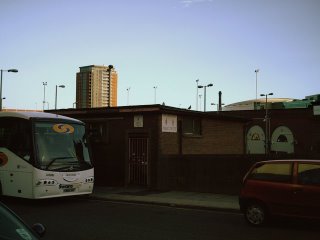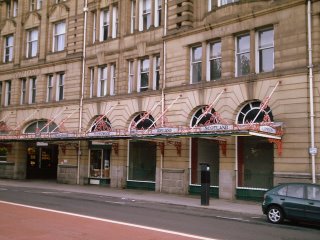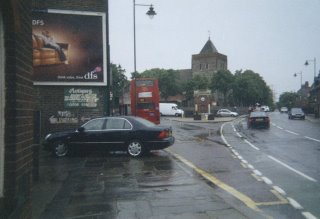This walk began with church bells ringing in my ear and ended with a welcome store. In between, I saw some spectacular storms and got soaked to the skin.
Chigwell, if you ignore the modern parts, is a pretty village with an attractive church and inn group, one of the few inn pictures Arthur Mee uses and it hasn’t changed a lot, except that the pargeting has come off and it is now black and white with a chef and brewer sign. There is also a school in mellow brick.

One of the morning services had just ended at the church so I went in and had a look round, with permission from the friendly rector. The church was obviously extended in the 19th Century with a new nave and chancel, the old nave and chancel serving as a side chapel. The old nave had a wonderful collection of funeral hatchments and the tower was supported on old oak beams with bells hung for full circle ringing. There was beautiful glass and banners with texts, including “be still and know that I am G*d”. I missed the monument to George Shillibeer, who brought 'busses to London in the nineteenth century but I saw the old brass to Archbishop Samuel Harsnett Primate of England, who had been vicar of Chigwell. He died in 1631 having been denounced for popery after having denounced an aspect of Calvinism. However he was a married man and had also written a book on how to expose those who pretended to be casting out evil spirits.
The church appeared bright and lively with its kindly rector. There were also other old houses in the Village and the Archbishop Harsnett school with venetian windows and mellow brick. The old cottages and shops were straight out of Dickens (who called Chigwell the finest place in the world – it isn’t though). The old inn could play host to Mr Pickwick. I left the village over the fields (remember this is London Transport Zone 6) with the bells of Chigwell church ringing in my ears. I crossed fields and more fields and found the first of the mud. This slowed my progress as my boots became encrusted with mud and the rain started to come down. However this gentle rain was but a rehearsal for the rest of the day and I strode on through the shower. I came into Chigwell Row passing a pony club show jumping field by the little yellow brick United Reformed Church with its dignified manse at the back and graveyard. Chigwell Row overlooks the Hainault forest and that’s all you can say about it really. The Hainault forest isn’t much of a forest but there is an informative visitor’s centre with fish tank, and a beacon. There are some beautiful open spaces for a sunny day out in the country. There’s also a rare breeds farm, however breeds only become rare for a reason, which could be poor eating quality. Although these places were not defended by the Corporation, like Epping Forrest and the south London commons, the LCC seems to have done a good job. We’ll meet the LCC a lot on this walk.
Here is the LCC Coat of arms.

After the Hainalt forest the walk led me through a golf course. At least this wasn’t muddy and the path was well waymarked although being Sunday afternoon there were many golfers about.
I soon left the golf course to cross fields with a view of the towers of Romford. There were many more muddy tracks here. I soon went up the hill to view the light glinting off the top of Canary Wharf Tower like some far off emerald city. The Havering country park began as a large mansion, like most of them did but this was demolished in the depressed years of the 1930s and converted, more or less, into a people’s garden city. People were able to buy plots, sometimes for as little as £5, and would be able to erect bungalows on these plots in the days before planning permission. Usually the bungalows, if the owners had enough money to build them, were little more than huts, but these were part of a fairly strong back to the land and hutment movement in the aftermath of the first world war. Of course the gas, water and electricity companies could not be persuaded to lay on utilities and the plots were often many miles from transport facilities. Peacehaven - perhaps the saddest monument to the 1918 peace - was built in this way, with some of the plots given away in a News of the World competition. Eventually hutment inhabitants, where they never got good title to the land and where there were no utilities, had to be dealt with and the LCC bought the land in the 1950s and turned it into a country park free of development. There are some giant (comparitively small) redwood trees in the park which will grow larger in time.
The next village was Havering Atte Bower, where our kings and queens have walked. The village stocks and whipping post are preserved on the village green but there is no trace of the former royal palace or even the original village church the current one being 19th century. This village is where Joan of Navarre, queen to Henry IV lived. The queen was accused of the heresy of witchcraft, but was never brought to trial, even in those days when witchcraft was a dread reality. Historians believe that money was the motivation, and when needs were not so pressing they released joan and what remained of her money to live out her days at Havering Atte Bower.
Leaving the village I walked through some more muddy fields keeping in view a round tower known as The tea caddy. I suspect it was a clock for the workers in the fields. I came to some ornate metal gateposts which grace the entrance to Pyrgo Park, with its chapel visible later on the path. It was here that the storm finally broke, when I was on a ridge too! I have seen this quantity of rain very few times in my life and the lightning flashes and thunder made me think of Beethoven (the composer not the dog) but I wished I had a dog with me. I got soaked to the skin. It was so wet I could not take a picture of or even properly see the building that looked like Castle Drogo, but perhaps more modern. Eventually I came to Paternoster Lane after slipping several times. This road was more like a river but at the end was the Castle Drogo like house I admired from the ridge. It was very modern. The road led me down to The Bear, a sizzling inn. By now I was thoroughly soaked and ready for a sizzling platter, preferably applied to my backside to dry my clothes. But I made do with a pint and bag of crisps and a blast under the warm air dryer in the Gents. Setting out from the pub I walked down Tees Avenue in the LCC out of county estate, starting to resemble the River Tees, to walk in the little dell where flows Carter’s brook which becomes Paine’s Brook and then the River Ingrebourne. Understandably this was white water rapids after the storms, and although it poured down on the rest of the walk I didn’t notice a thing with the pint inside me. Thank heaven for alcohol, the cup that really does cheer!
Continuing along the proto Ingrebourne (our rivers have Saxon names) I came to the central park of Gidea Park, fine examples of 1950s LCC housing very different for Mr and Mrs Citizen, the first tenants, and their four children from the three attic rooms where the six of them had been crammed together. The neatly designed cottages in traditional style round a village green, with old people’s dwellings at the corners, and new shops being opened by both the private trade and the London Coöperative Society led to these dwellings becoming highly desirable and sought after. Mr and Mrs Citizen now had room to grow, blossom and, protected by their democratic landlord from arbitrary eviction, they flourished. Is it any surprise then, that in the property owning democracy they sought to purchase their houses and did so when given a chance? And as a bonus Mr and Mrs Citizen were given a discount that made the purchase easy. The tenants cannot be blamed for buying their houses. The Government can be blamed for not allowing the council to use receipts from house sales to build replacement dwellings.


The last open space on the section of the loop was a small grassed area with what looked like a world war two bunker in it. After this there were some boring suburban streets (not LCC alas) but at the end of it all was a former London Coöperative Society shop refurbished to Welcome Format and welcome it was too. I caught the train home from Harold Wood station that had the original name over the door – London North Eastern Railway.
A muddy, soaking but still impressive day. I want to do this walk in fine weather as I expect it would be most rewarding.










